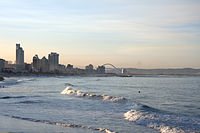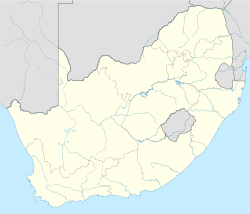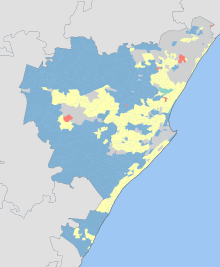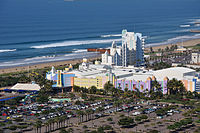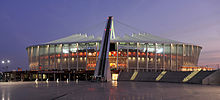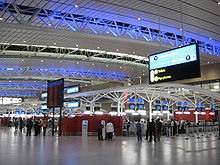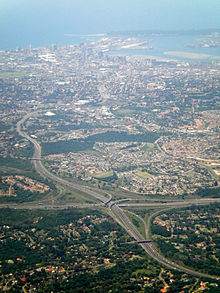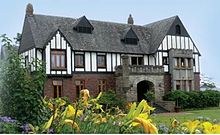- Durban
-
Durban — City — Durban Beachfront Skyline Location of Durban in South Africa Coordinates: 29°53′S 31°03′E / 29.883°S 31.05°ECoordinates: 29°53′S 31°03′E / 29.883°S 31.05°E Country  South Africa
South AfricaProvince KwaZulu-Natal Metropolitan municipality eThekwini Established 1835 Population (2007)[1] – Total 3,468,086 – Density 1,513/km2 (3,918.7/sq mi) Demonym Durbanite Time zone South Africa Standard Time (UTC+2) Postal Code 4001 Area code(s) 031 Website www.durban.gov.za Durban (Zulu: eThekwini, from itheku meaning 'bay') is the largest city in the South African province of KwaZulu-Natal and the third largest city in South Africa. It forms part of the eThekwini metropolitan municipality. Durban is famous for being the busiest port in South Africa. It is also seen as one of the major centres of tourism because of the city's warm subtropical climate and extensive beaches. The municipality, which includes neighbouring towns, has a population of almost 4.5 million,[1] making the combined municipality the biggest city on the east coast of the African continent. The metropolitan land area of 2,292 square kilometres (885 sq mi) is comparatively larger than other South African cities, resulting in a somewhat lower population density of 1,513 /km2 (3,920 /sq mi).[2]
History
Archaeological evidence from the Drakensberg mountains suggests that the Durban area has been inhabited by communities of hunter-gatherers since 100,000 BC. These people lived throughout the area of present day KwaZulu-Natal until the expansion of Bantu farmers and pastoralists from the north saw their gradual displacement,incorporation or extermination.
Little is known of the history of the first residents, as there is no written history of the area until it was sighted by Portuguese explorer Vasco da Gama, who sailed parallel to the KwaZulu-Natal coast at Christmastide in 1497 while searching for a route from Europe to India. He named the area "Natal", or Christmas in Portuguese.[3]
First European settlers
The modern city of Durban dates from 1824, when a party of 25 men under British Lieutenant F. G. Farewell arrived from the Cape Colony and established a settlement on the northern shore of the Bay of Natal, near today's Farewell Square. Accompanying Farewell was an adventurer named Henry Francis Fynn. Fynn was able to befriend the Zulu King Shaka by helping him to recover from a stab wound he suffered in battle. As a token of Shaka's gratitude, he granted Fynn a "30-mile strip of coast a hundred miles in depth."[4]
During a meeting of 35 European residents in Fynn's territory on 23 June 1835, it was decided to build a capital town and name it "d'Urban" after Sir Benjamin d'Urban, then governor of the Cape Colony.[5]
Republic of Natalia
The Voortrekkers established the Republic of Natalia in 1838, with its capital at Pietermaritzburg.
Reports filtered back to the Cape Colony of mistreatment of the Zulu by the Voortrekkers. The governor of the Cape Colony dispatched a force under Captain Charlton Smith to re-establish British rule in Port Natal. The force arrived on 4 May 1842 and built a fortification that was later to be The Old Fort. On the night of 23/24 May 1842 the British attacked the Voortrekker camp at Congella. The attack failed, and the British had to withdraw to their camp which was put under siege. A local trader Dick King and his servant Ndongeni were able to escape the blockade and rode to Grahamstown, a distance of 600 km (372.82 mi) in fourteen days to raise reinforcements. The reinforcements arrived in Durban 20 days later; the Voortrekkers retreated, and the siege was raised.[6]
Fierce conflict with the Zulu population led to the evacuation of Durban, and eventually the Afrikaners accepted British annexation in 1844 under military pressure.
British colonial rule
A British governor was appointed to the region and many settlers emigrated from Europe and the Cape Colony. The British established a sugar cane industry in the 1860s. Farm owners had a difficult time attracting Zulu labourers to work on their plantations, so the British brought thousands of indentured labourers from India on twenty five-year contracts. As a result of the importation of Indian labourers, Durban has the largest Asian community in South Africa and the African continent.
Durban's historic regalia
When the Borough of Durban was proclaimed in 1854, the council had to procure a seal for official documents. The seal was produced in 1855 and was replaced in 1882. The new seal contained a coat of arms without helmet or mantling that combined the coats of arms of Sir Benjamin D’Urban and Sir Benjamin Pine. An application was made to register the coat of arms with the College of Arms in 1906, but this application was rejected on grounds that the design implied that D’Urban and Pine were husband and wife! Nevertheless, the coat of arms appeared on the council’s stationery from about 1912. The following year, a helmet and mantling was added to the council’s stationery and to the new city seal that was made in 1936.
The blazon of the arms registered by the South African Bureau of Heraldry and granted to Durban on 9 February 1979. The coat of arms fell into disuse with the reorganisation of the South African local government structure in 2000. The seal ceased to be used in 1995.[7][8]
Durban today
Today, Durban is the busiest container port in Africa[9] and a popular tourist destination. The Golden Mile, developed as a welcoming tourist destination in the 1970s, as well as Durban at large, provide ample tourist attractions, particularly for people on holiday from Johannesburg. It lost its international holiday pre-eminence to Cape Town in the 1990s, but remains more popular among domestic tourists. The city is also a gateway to the national parks and historic sites of Zululand and the Drakensberg.
Government and politics
Further information: Mayors of DurbanThe eThekwini Metropolitan Municipality Durban was formed in 1994 after South Africa's first democratic elections. The first democtratic mayor of Durban was Sipho Ngwenya. The mayor is elected for a five year term, however Sipho Ngwenya only served 2 of 5 year democratic term. The city of Durban was subjected to city structural and name changes immediately after the country first democratic elections. The change was from the Greater city of Durban in 1994 to Durban UniCity in July 1996 to eThekwini Metropolitan Municipality in 1999. In July 1996, Obed Mlaba, was appointed mayor of Durban UniCity, then in 1999 he was elected to mayor of EThekwini municipality of Durban, he was re-elected to his second term in 2006. Following the May 2011 Local Government election James Nxumalo, the former Speaker of the Council, was elected as the new mayor.
The name of the Durban municipal government, prior to the post-apartheid reorganisations of municipalities, was the Durban Corporation or City of Durban.[10]
The Freedom of Expression Institute has reported that there have been problems with the Municipality allowing shack dwellers their legal right to march.[11]
There have been reports of serious corruption by high level city officials.[12][13]
Geography and climate
Durban is characterised by a mild subtropical climate with warm wet summers and mild moist to dry winters, which are frost-free. However, due to large altitude variations, some western suburbs get slightly chilly in the winter. Durban has an annual rainfall of 1,009 millimetres (39.7 in) The average annual temperature is 21 °C (70 °F), with daytime maxima peaking from January to March at 28 °C (82 °F) and the minimum is 21 °C (70 °F), dropping to daytime highs from June to August of 23 °C (73 °F) and the minimum is 11 °C (52 °F). Sunrise in Durban is at 04h45 *(04h15) and sunset is 19h00 *(19h30) in summer & rise at 06h30 *(06h10) and set at 17h20 *(17h00) in winter. (* = dawn and dusk)
Durban and its suburbs are hilly, with very few flat areas, except for locations in and around the central business district and the harbour. The western suburbs off Hillcrest and Kloof are significantly higher above sea-level, reaching up to 850 metres (2,789 ft) in the community of Botha's Hill. Many gorges and ravines are found within the metropolitan area. There is almost no true coastal plain.
Climate data for Durban Month Jan Feb Mar Apr May Jun Jul Aug Sep Oct Nov Dec Year Record high °C (°F) 36
(97)34
(93)35
(95)36
(97)34
(93)36
(97)34
(93)36
(97)37
(99)40
(104)34
(93)36
(97)40
(104)Average high °C (°F) 28
(82)28
(82)28
(82)26
(79)25
(77)23
(73)23
(73)23
(73)23
(73)24
(75)25
(77)27
(81)25 Average low °C (°F) 21
(70)21
(70)20
(68)17
(63)14
(57)11
(52)11
(52)13
(55)15
(59)17
(63)18
(64)20
(68)17 Record low °C (°F) 14
(57)13
(55)12
(54)9
(48)5
(41)4
(39)3
(37)3
(37)5
(41)8
(46)10
(50)12
(54)3
(37)Rainfall mm (inches) 134
(5.28)113
(4.45)120
(4.72)73
(2.87)59
(2.32)28
(1.1)39
(1.54)62
(2.44)73
(2.87)98
(3.86)108
(4.25)102
(4.02)1,009
(39.72)Avg. rainy days 15 13 13 9 7 5 5 7 11 15 16 15 130 Source: SAWS[14] Demographics
Durban is ethnically diverse, with a cultural richness of mixed beliefs and traditions. Zulus form the largest single ethnic group.
The city’s demographics indicate that 68% of the population are of working age, and 38% of the people in Durban are under the age of 19 years.[15] It has an extremely high rate of HIV/AIDS at 32%.
Economy
The Durban Metropolitan Area (DMA) has a large and diversified economy with strong manufacturing, tourism, transportation, finance and government sectors. Its coastal location and large port gives it comparative advantage over many other centres in South Africa for export-related industry. Durban's mild climate, warm marine current and culturally diverse population has also provided a drawcard for tourism to the region.
There has, however, been little growth in the number of jobs provided by DMA's formal sector over the past 20 years. The manufacturing sector, which is second only to government in the number of jobs provided, has been shedding jobs as firms restructure and become more capital intensive. High rates of crime have become a disincentive to growth in tourism and many other sectors. Despite a dynamic and growing small and micro business sector, the DMA has very high rates of unemployment, reaching over 30% in some areas of the city. There are still few economic opportunities in the former township areas.
The central business district has experienced an economic decline due to crime and grime. Many corporates have relocated due to rampant decentralisation, especially to the Umhlanga area north of the city. This region has become a new central business district near the Gateway Theatre of Shopping.
Efforts have recently been made to attract business back to the city, with the new Durban Point Waterfront development south-east of downtown sporting uShaka Marine World and many new residential and leisure developments. It is hoped efforts by the city to clean up the business district, new developments in Point and the 2010 FIFA World Cup stadium north of the CBD (Moses Mabidha Stadium) will aid in the economic turnaround.
Durban's economic contribution to the region
The Durban Metropolitan Area is the main economic driver in KwaZulu-Natal, contributing over half of the province's output, employment and income. In national terms, Durban is the second most important economic complex after Gauteng, accounting for 15% of national output, 14% of household income and 11% of national employment. Regional development corridors link Durban northwards to Richards Bay and Maputo, and westward to Pietermaritzburg and Johannesburg.
Informal sector
The City's responses to informal housing have been met with a mixed reaction. The City won two Vuna awards[16][17] from the state. But its treatment of shack dwellers has been strongly criticised by a report from the United Nations linked Centre on Housing Rights and Evictions[18] and there has also been strong criticism of the city's treatment of street traders[19][20] and street children.[21]
Civil Society
There are a number of prominent civil society organisations based in ethekwini. These include: Abahlali baseMjondolo (shackdwellers') movement[22] which has over 10,000 members, the Diakonia Council of Churches, the Right2Know Campaign, and the South African Unemployed Peoples' Movement.[23][24][25][26][27][28]
Visitor attractions
- The Golden Mile
- Suncoast Casino and Entertainment World
- The Victoria Embankment (also known as The Esplanade) is home to many tourist sites.
- The International Convention Centre (ICC) – the leading conference centre in Africa for the last 5 years, and rated 4th in the world in 2005.
- uShaka Marine World, one of the largest Aquariums in the world.
- Sahara Stadium Kingsmead is a major test match and one-day cricket venue.
- Kings Park Stadium (Previously known for sponsorship reasons as ABSA Stadium) is host to the internationally renowned Sharks Rugby Team.
- Gateway Theatre of Shopping
- Greyville Racecourse (home of the Durban July Handicap) and Durban Country Club and golf course.
- Moses Mabhida Stadium
- Umgeni River Bird Park
- The Markets of Warwick - possibly the Largest informal street market in South Africa
Communications and media
Two major English-language daily newspapers are published in Durban, both part of the Independent Newspapers, the national group owned by Irish media magnate Tony O'Reilly. These are the morning editions of The Mercury and the afternoon Daily News. Like most news media in South Africa, they have seen declining circulations in recent years. Major Zulu language papers comprise "Isolezwe" ( Independent Newspapers), "UmAfrika" and "Ilanga", the latter being seen to be politically aligned to the IFP. Independent Newspapers also publish "Post", a newspaper aimed largely at the Indian community. A national Sunday paper, the "Sunday Tribune" is also published by Independent Newspapers as is the "Independent on Saturday".
A variety of free weekly suburban newspapers are published by the Caxton Group and there are numerous "community" newspapers, some of which are short lived and others which have had stable tenure. The Tabloid Newspaper group situated in North Coast Road,Durban has also added to the variety of community newspapers.They have ten newspaper publications, three of them in the isiZulu language. Community newspapers target specific areas or zones rooting out and exposing community issues like a magnifying glass. These papers rely solely on advertising revenue and are delivered to each house hold irrespective of race or wealth. Many journalists gain experience at these papers before moving on to other major national publications.
A major city initiative is the eZasegagasini Metro Gazette ([3]). It is the official newspaper of the eThekwini Municipality, through which ratepayers and residents are kept informed about projects, programmes and activities of the eThekwini Municipality. It is also a forum for readers’ views. Published fortnightly, the newspaper hits the streets on a Friday morning, with 400 000 copies distributed in English and Zulu. The publication is an in-house product of the Municipality’s Communications Department.
A major English language radio station, East Coast Radio ([4]), operates out of Durban and is owned by SA media giant Kagiso Media. The national broadcaster, the SABC, has regional offices in Durban and operates two major stations here, the Zulu language "Ukhozi FM" with a huge national listenership of over 5 million, and Radio Lotus, aimed at "Indian" listeners. The other SABC national stations have smaller regional offices here, as does TV for news links and sports broadcasts. There are a number of smaller stations which are independent, having been granted licences by ICASA, the national agency charged with the issue of broadcast licences.
Sports teams and stadia
Durban is home to two closely related rugby union teams, the Natal Sharks, who compete in the domestic Currie Cup competition, and the Sharks, who compete in the international Super Rugby competition. Both teams play out of the 56,000 capacity Kings Park Stadium, sometimes referred to as the Shark Tank – currently it is known as the Mr Price Kings Park for sponsorship reasons.
The City is also home to three clubs in the Premier Soccer League—AmaZulu, Thanda Royal Zulu and the Golden Arrows. AmaZulu play most of their home games in their own Princess Magogo Stadium, but will take especially important fixtures to ABSA Stadium. Similarly, the Golden Arrows have their own stadium, King Zwelithini Stadium in the suburb of Umlazi, but play their most important matches in ABSA Stadium. Durban used to be home to a fourth team, Manning Rangers, who won several honours including the league championship.
Durban is also host to the Dolphins, the provincial cricket team. Shaun Pollock, Lance Klusener and Barry Richards all come from the Dolphins (although it was formally called Natal). Cricket in Durban is played at Sahara Stadium Kingsmead.
Durban hosted matches in the 2003 ICC Cricket World Cup. In 2007 the city hosted nine matches, including a semi-final, as part of the inaugural ICC World Twenty20. The 2009 IPL season was played in South Africa, and Durban was selected as a venue. 2010 saw the city host six matches, including a semi-final, in the 2010 Champions League Twenty20.
Durban was one of the host cities of the 2010 FIFA World Cup and is the host of an A1GP motor race, driven on a street track. Durban hosted the 123rd IOC Session in July 2011.
The City is home to Greyville Racecourse, a major Thoroughbred horse racing venue which annually hosts a number of prestigious races including the country's premier event, the July Handicap, and the premier staying event in South Africa, the Gold Cup. Another well-equipped Racecourse is located at Clairwood, just south of the city centre and not far from Durban International Airport.
A professional Tennis venue is located at Westridge Park near The Berea, and an Olympic-standard swimming pool is found in the Kings Park Sporting Precinct. In addition to these venues, Durban has facilities for Water Polo, Hockey, and other sports, most notably the outstanding beach front which has played host to numerous water sports events such as the Mr Price Pro (previously known as the Gunston 500) surfing competition and the related Ocean Action festival. Beach volleyball is regularly played on local beaches and Powerboat racing has taken place in the Harbour. Durban and surrounding areas are also well patronised by Professional and Amateur golfers, with the golf course at Durban Country Club near the CBD being particularly well-known.
Transport
Air
Main article: List of airports in the Durban areaKing Shaka International Airport services both domestic and international flights, with regularly scheduled service to Dubai, Swaziland, Mozambique, and Mauritius. The airport opened in May 2010, replacing all operations from Durban International Airport, which handled four million passengers in 2005, up over 15 percent from 2004. King Shaka International Airport was constructed at La Mercy, about 36 kilometres (22 mi) north of central Durban. All operations at Durban International have been transferred to King Shaka International as of 1 May 2010; with plans for flights to Singapore, London and Australia.
The Durban International Airport was used by the South African Defence Force during the 2010 FIFA World Cup and as a secondary airport to handle overflow.
The airport serves as a major gateway for travellers to KwaZulu-Natal and the Drakensberg.
Sea
Durban has a long tradition as a port city. The Port of Durban, which was formerly known as the Port of Natal, is one of the few natural harbours between Port Elizabeth and Maputo, and is also located at the beginning of a particular weather phenomenon which can cause extremely violent seas. These two features made Durban an extremely busy port of call for ship repairs when the port was opened in the 1840s. The Port of Durban is now the busiest port in South Africa, as well as the third busiest container port in the Southern Hemisphere.
The modern Port of Durban grew around trade from Johannesburg, as the industrial and mining capital of South Africa is not located on any navigable body of water. Thus, products being shipped from Johannesburg outside of South Africa have to be loaded onto trucks or railways and transported to Durban. The Port of Maputo was unavailable for use until the early 1990s due to civil war and an embargo against South African products. There is now an intense rivalry between Durban and Maputo for shipping business.
Salisbury Island now joined to the mainland and part of the Port of Durban, was formerly a full naval base until it was downgraded in 2002. It now contains a naval station and other military facilities. The future of the base, however, is uncertain, as there is increasing demand to use Salisbury Island as part of the port facilities.
Rail
Durban featured the first operating steam railway in South Africa when the Natal Railway Company started operating a line between the Point and the city of Durban in 1860.[29]
Durban is well-served by railways due to its role as the largest trans-shipment point for goods from the interior of South Africa. Shosholoza Meyl, the passenger rail service of Spoornet, operates two long-distance passenger rail services from Durban: a daily service to and from Johannesburg via Pietermaritzburg, and a weekly service to and from Cape Town via Kimberley and Bloemfontein. These trains terminate at Durban railway station.
Metrorail operates a commuter rail service in Durban and the surrounding area. The Metrorail network runs from Durban Station outwards as far as Stanger on the north coast, Kelso on the south coast, and Cato Ridge inland.
A high speed rail link has been proposed, between Johannesburg and Durban.[30]
Roads
The City's main position as a port of entry onto the southern African continent has led to a development of national roads around it. One such highway starts in Durban, and one passes through it. The N3 Western Freeway; which links Durban with the economic hinterland of Gauteng heads west out of the city. The N2 Outer Ring Road links Durban with the Eastern Cape to the south, and Mpumalanga in the north. The Western Freeway is particularly important because freight is shipped by truck to and from the Witwatersrand for transfer to the port.
The N3 Western Freeway starts in the central business district and heads west under Tollgate Bridge and through the suburbs of Sherwood and Mayville. The EB Cloete Interchange (which is informally nicknamed the Spaghetti Junction) lies to the east of Westville, allowing for transfer of traffic between the N2 Outer Ring Road and the Western Freeway.
The N2 Outer Ring Road cuts through the city from the north coast to the south coast. It provides a vital link to the Durban International Airport and to the coastal towns (such as Scottburgh and Stanger) that rely on Durban.
Durban also has a system of freeway and dual arterial metropolitan routes, which connect the sprawling suburbs that lie to the north, west and south of the city. The M4 exists in two segments: The northern segment, named the Leo Boyd Highway, starts as an alternative highway at Ballito where it separates from the N2. It passes through the northern suburbs of Umghlanga and La-Lucia where it becomes a dual carriageway and ends at the northern edge of the CBD. The southern segment of the M4, the Albert Luthuli [5] Highway, starts at the southern edge of the CBD, connecting through to the Durban International Airport, where it once again reconnects with the N2 Outer Ring Road.
The M7 connects the southern industrial basin with the N3 and Pinetown via Queensburgh via the N2. The M19 connects the northern suburbs with Pinetown via Westville.
The M13 is an untolled alternative to the N3 Western Freeway (which is tolled at Mariannhill). It also feeds traffic through Gillitts, Kloof, and Westville. In the Westville area it is called the Jan Smuts Highway, while in the Kloof area it is named the Arthur Hopewell Highway.
A number of streets in Durban were renamed in the late 2000s to the names of figures related to the anti-apartheid struggle, persons related to liberation movements around the world (including Che Guevera, Kenneth Kaunda and SWAPO), and others associated with the governing African National Congress.[31] A few street names were changed in the first round of renaming, followed by a larger second round.[32] The renamings provoked incidents of vandalism,[33] as well as protests from opposition parties [34] and members of the public.[35]
Buses
Remant Alton, a company which bought Durban Transport in 2003, operated scheduled bus services throughout the Durban metropolitan area. However, Remant Alton's services were suspended in March 2009 due to violent industrial action by its employees, unroadworthy vehicles and the company's poor financial position.[36] Remant Alton is barely functional, has lost key individuals,[37] suffered the loss of 56 buses in a fire, and had many of the remainder impounded due to unroadworthiness.[citation needed] This has left Durban with a poorly functioning formal public transport system.[citation needed]
The Durban People Mover is a tourist-oriented bus service which runs every 15 minutes and consists of three routes within the central business district and along the beachfront, connecting various attractions.[38]
Several companies run long-distance bus services from Durban to the other cities in South Africa. Buses have a long history in Durban. Most of them run by Indian owners since the early 1930`s. Privately owned buses who are not subsidised by the government service the communities timeoulsy. Buses operate in all areas of the eThekwini Municipality. Since 2003 buses have been violently taken out of the routes and bus ranks by taxi operators. This has brought bus operations into disarray. Bus owners have bought into taxi operations using their bus permits to make a living.
Taxis
Durban has two kinds of taxis: metered taxis and minibus taxis. Unlike many cities, metered taxis are not allowed to drive around the city to solicit fares and instead must be called and ordered to a specific location. There are a number of companies which service the Durban and surrounding regions. These taxis can also be called upon for airport transfers, point to point pick ups and shuttles.
Mini bus taxis are the standard form of transport for the majority of the population who cannot afford private cars.[39][40][41] With the high demand for transport by the working class of South Africa, minibus taxis are often filled over their legal passenger allowance, making for high casualty rates when minibuses are involved in accidents. Minibuses are generally owned and operated in fleets, and inter-operator violence flares up from time to time, especially as turf wars over lucrative taxi routes occur.[42]
Rickshaws
Durban is also famous for its iconic Zulu Rickshaw pullers navigating throughout the city. These colourful characters are famous for their giant, vibrant hats and costumes. Although they had been a mode of transportation since the early 1900s, they have been displaced by other forms of motorised transport, and the 25 or so remaining rickshaws mostly cater to tourists today.[43]
Suburbs
Educational institutions
Private schools
- Al Falaah College
- Clifton School
- Eden College, South Africa
- Crawford College, La Lucia
- Crawford College, North Coast
- Deutsche Schule Durban
- Durban Girls' College
- Highbury Preparatory School
- Hillcrest Christian Academy
- Highway College
- Holy Family College
- Eden College Durban
- Glenwood Christian School
- Kearsney College
- Inanda Seminary
- St Henry's Marist Brothers' College
- Maris Stella School
- Oakridge College
- Orient Islamic School
- Jasmine Codd School
- St. Mary's D.S.G.
- Thomas More College
- Roseway Waldorf School
- Star College
- Victory Christian Academy
Public schools
- Apollo Secondary School
- Arena Park Secondary School
- Atholton Primary School
- Avoca Primary School
- Avoca Secondary School
- Bechet High School
- Berea Primary School
- Bonela Primary School
- Brighton Beach Senior Primary
- Carrington Heights Primary School
- Chatsworth High School
- Chelsea Preparatory School
- Crystalpiont Secondary School
- Daleview Secondary School
- Dawnridge Primary school
- Dr AD Lazarus Secondary School
- Durban Academy High School
- Durban Girls' High School (DGHS)
- Durban High School (DHS)
- Durban North College
- Effingham Primary School
- Effingham Secondary School
- Foresthaven Secondary
- Gelofte High School
- George Campbell School of Technology
- Glenwood High School
- Glenwood Preparatory School
- Glenover Secondary school
- Greenbury Secondary School
- Greenheights Primary School
- Grosvenor Boys High School
- Grosvenor Girls High School
- Grove End Secondary School
- Hillgrove Secondary School (HSS)
- Hillcrest High School
- Hunt Road Secondary
- Isipingo Secondary School[44]
- John Dube High School
- Kharwastan Secondary School
- Kingsway High School
- Kloof High School
- Kloof Junior Primary School
- Kloof Pre-Primary School
- Kloof Senior Primary School
- Montclair Senior Primary School
- Mowat Park High School
- Mzuvele Secondary School
- New Forest High School
- New Germany Primary School
- Northlands Girls' High School
- Northmead Secondary School
- Northwood School
- NqabakaZulu Comprehensive High School
Ogwini Comprehensive High School
- Open Air School
- Palmcroft Primary School
- Parkhill Secondary School
- Parlock Primary School
- Penzance Primary School
- Pinetown Boys' High School
- Pinetown Girls' High School
- Port Natal High School
- Queensburgh Girls' High School
- Queensburgh High School
- Reservoir Hills Secondary School
- Ridge Park College
- Sastri College
- Sibonelo High School
Sishosonke High School
- Sivananda Technical College and High School
- Stanmore Secondary School
Swelihle High School
- Virginia Preparatory School[45]
Vukuzakhe High School
- Werda Hoërskool
- Westcliff Secondary School
- Westham Secondary School
- Westville Boys' High School
- Westville Girls' High School
- Wingen Heights Secondary School
- Werda High School
- Zakhe High School
- Zeph Dlomo High School
- Zwelibanzi High School
Tertiary institutions
International relations
Twin towns — Sister cities
 Alexandria, Egypt
Alexandria, Egypt Baku, Azerbaijan
Baku, Azerbaijan Chicago, Illinois, United States
Chicago, Illinois, United States Leeds, United Kingdom,
Leeds, United Kingdom, Rotterdam, Netherlands
Rotterdam, Netherlands
 Le Port, Reunion Island, France
Le Port, Reunion Island, France Daejeon, South Korea
Daejeon, South Korea Bulawayo, Zimbabwe
Bulawayo, Zimbabwe New Orleans, Louisiana, United States
New Orleans, Louisiana, United States Oran, Algeria
Oran, Algeria
See also
- Art Deco in Durban
- Durban Industry Climate Change Partnership Project (DICCPP)
- World Conference against Racism 2001 – held in Durban
- Durban International Film Festival
References
- ^ a b Statistics South Africa, Community Survey, 2007, Basic Results Municipalities (pdf-file) Retrieved on 2008-03-23.
- ^ Municipal Demarcation Board, South Africa Retrieved on 2008-03-23.
- ^ Eric A. Walker (1964) [1928]. "Chapter I – The discovery". A History of Southern Africa. London: Longmans.
- ^ Eric A. Walker (1964) [1928]. "Chapter VII – The period of change 1823–36". A History of Southern Africa. London: Longmans.
- ^ Adrian Koopman. "The Names and the Naming of Durban". Natalia, the Journal of the Natal Society. Archived from the original on 3 November 2007. http://web.archive.org/web/20071103144254/http://www.durban.gov.za/durban/discover-durban/our-durban/history/naming. Retrieved 9 July 2008.
- ^ T.V. Bulpin (1977) [1966]. "Chapter XII – Twilight of the Republic". Natal and the Zulu Country. Cape Town: T.V. Bulpin Publications.
- ^ Bruce Berry (8 May 2006). "Durban (South Africa)". http://www.crwflags.com/fotw/flags/za-kn-dur.html. Retrieved 8 July 2010.
- ^ Ralf Hartemink. "Durban". http://www.ngw.nl/int/zaf/d/durban.htm. Retrieved 8 July 2010.
- ^ "South Africa's transport network". SouthAfrica.info. http://www.southafrica.info/business/economy/infrastructure/transport.htm. Retrieved 4 April 2011.
- ^ Durban Corporation BylawseThekwini Online
- ^ "ngopulse". ngopulse. http://www.ngopulse.org/press-release/fxi-fxis-anti-censorship-programme-releases-seventh-report. Retrieved 2 July 2010.
- ^ Hawks set to arrest top eThekwini officials, BONGANI MTHETHWA and MANDLA ZULU, Sunday Times, 5 March 2011
- ^ ANC chief's fat-cat deals, By Wendy Jasson da Costa, IOL, 12 March 2011
- ^ "Climate Data for Durban". South African Weather Service. July 2011. http://old.weathersa.co.za/Climat/Climstats/DurbanStats.jsp. Retrieved 6 March 2010.
- ^ "durban.gov.za". http://www.durban.gov.za/durban/government/cifal/about/durban-ethekwini.
- ^ "The Vuna Awards". Department of Provincial and Local Government, Republic of South Africa. http://www.thedplg.gov.za/vuna/.
- ^ "Why eThekwini Municipality won the Vuna Award for best run metropolitan". Ethekwini Municipality Communications Department. http://www.durban.gov.za/durban/government/munadmin/media/press/best_run/view.
- ^ South Africa: Business as Usual – housing rights and slum eradication in Durban, Centre on Housing Rights & Evictions, Geneva, 2008
- ^ From best practice to Pariah: the case of Durban, South Africa by Pat Horn, Street Net[dead link]
- ^ Criminalising the Livelihoods of the Poor: The impact of formalising informal trading on female and migrant traders in Durban by Blessing Karumbidza, Socio-Economic Rights Institute of South Africa (February 2011)
- ^ Life in 'Tin Can Town' for the South Africans evicted ahead of World Cup, David Smith, The Guardian, 1 April 2010
- ^ Struggle Is a School: The Rise of a Shack Dwellers’ Movement in Durban, South Africa, Richard Pitthouse, Monthly Review, 2006
- ^ The opening remarks of S'bu Zikode, President of the Abahlali baseMjondolo movement of South Africa,at the Center for Place, Culture and Politics at the CUNY Graduate Center (NYC), 16 November 2010
- ^ ANC Intimidates Witness X, More Intimidation and More Killing in Kennedy Road, 23 December 2010
- ^ Churches want justice
- ^ 200 March against information bill
- ^ http://allafrica.com/stories/200901070039.html Churches Ask Parties to Preach Tolerance
- ^ No mercy, no grants, says Mkhize
- ^ Steam Locomotives of the South African Railways, vol 1: 1859–1910, (D.F. Holland, 1971), p11, 20–21, ISBN 0 7153 5382 9
- ^ "Railway Gazette: Ambitious plans will still need funding". http://www.railwaygazette.com/news/single-view/view/ambitious-plans-will-still-need-funding/browse/3.html. Retrieved 19 September 2010.
- ^ [1][dead link]
- ^ Independent Newspapers Online (2008-07-02). "New road names go up - Politics | IOL News". IOL.co.za. http://www.iol.co.za/news/politics/new-road-names-go-up-1.406687. Retrieved 2011-09-16.
- ^ "Lonely Planet South Africa, Lesotho ... - Google Books". Books.google.com. http://books.google.com/books?id=p4pGABdauysC&lpg=PA302&dq=durban%20street%20signs&pg=PA302#v=onepage&q=durban%20street%20signs&f=false. Retrieved 2011-09-16.
- ^ [2][dead link]
- ^ Wines, Michael (2007-05-25). "Where the Road to Renaming Does Not Run Smooth - New York Times". Durban (South Africa): Nytimes.com. http://www.nytimes.com/2007/05/25/world/africa/25durban.html. Retrieved 2011-09-16.
- ^ eThekwini Municipality (13 March 2009). "Notice From Remant Alton — Suspension Of Bus Commuter Service". http://www.durban.gov.za/durban/government/munadmin/media/press/pressitem.2009-03-13.2537462746/view. Retrieved 3 May 2009.
- ^ Independent Online. "Chief resigns in face of bus crisis". IOL. http://www.iol.co.za/index.php?set_id=1&click_id=13&art_id=vn20070420104248892C358861. Retrieved 5 May 2009.
- ^ Durban People Mover. "Durban People Mover ... The future begins here". http://durbanpeoplemover.co.za/. Retrieved 3 May 2009.
- ^ "Transport". CapeTown.org. http://www.cape-town.org/directory.asp?McatId=8.
- ^ "South Africa's minibus wars: uncontrollable law-defying minibuses oust buses and trains from transit". LookSmart. Archived from the original on 6 December 2007. http://web.archive.org/web/20071206115024/http://findarticles.com/p/articles/mi_go1566/is_200209/ai_n7215423.
- ^ "Transportation in Developing Countries: Greenhouse Gas Scenarios of south alabama". Pew Center. http://www.pewclimate.org/global-warming-in-depth/all_reports/transportation_in_south_africa/trans_sa_execsumm.cfm.
- ^ "Taxing Alternatives: Poverty Alleviation and the South African Taxi/Minibus Industry". Enterprise Africa! Research Publications. Archived from the original on 25 August 2006. http://web.archive.org/web/20060825221354/http://www.aworldconnected.org/article.php/1341.html.
- ^ Ethekwini Municipality Communications Department, edited by Fiona Wayman, Neville Grimmet and Angela Spencer. "Zulu Rickshaws". Durban.gov.za. http://www.durban.gov.za/durban/discover/history/our-town/rickshaws. Retrieved 2 July 2010.
- ^ "Isipingo Secondary School". Isipingosecondary.com. http://www.isipingosecondary.com/. Retrieved 2 July 2010.
- ^ "Virginia Preparatory School". Virginiaprep.co.za. 21 January 1958. http://www.virginiaprep.co.za/. Retrieved 2 July 2010.
- ^ "Sister Cities Home Page". http://www.durban.gov.za/durban/government/igr/idr/sister. eThekwini Online: The Official Site of the City of Durban
- ^ "Sister Cities of Guangzhou". Guangzhou Foreign Affairs Office. http://www.gzwaishi.gov.cn/Item/3970.aspx. Retrieved 10 February 2010.
External links
- Official Durban city website
- Durban travel guide from Wikitravel
- Durban Online, Tourism, Entertainment, Accommodation and more
- Municipal Demarcation Board
- Statssal
- Independent Electoral Commission 2004 election results
Suburbs of Durban Central Asherville · Berea (area) · The Bluff · Cato Manor · Essenwood · Glenwood · Mayville · Morningside · Overport · (area) Stamford Hill · Sydenham · Windermere · Yellowwood ParkNorthern Western Botha's Hill · Cowies Hill · Gillitts · Hillcrest · Kloof · New Germany · Pinetown · Queensburgh · Westville · Winston Park · ShallcrossSouthern Other Bellair · Montclair · Reservoir Hills · Rossburgh · Umbilo · Woodhaven · WoodlandsProvince of KwaZulu-Natal, South Africa Metropolitan
MunicipalitieseThekwini (Durban)District
and Local
MunicipalitiesIngwe · Kwa Sani · Greater Kokstad · Ubuhlebezwe · UmzimkhuluCategories:- Durban
- Cities in South Africa
- EThekwini Metropolitan Municipality
- History of KwaZulu-Natal
- Indian Ocean
- Populated places established in 1824
- Populated places in KwaZulu-Natal
- Port cities in South Africa
- Populated coastal places in South Africa
Wikimedia Foundation. 2010.

